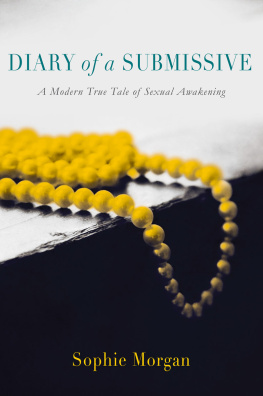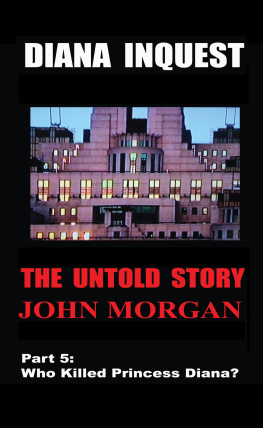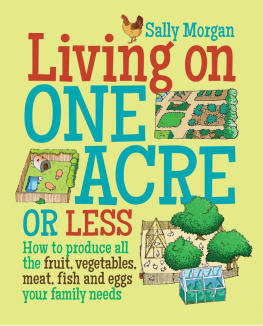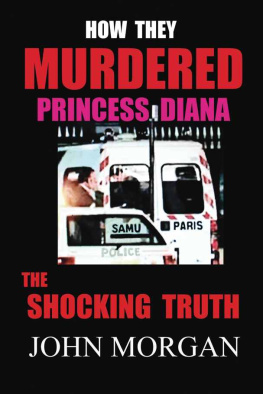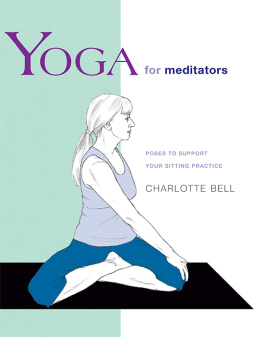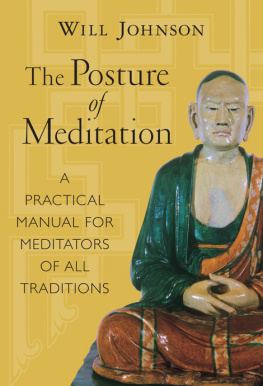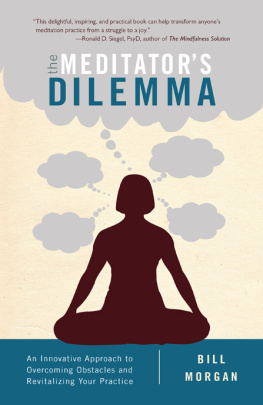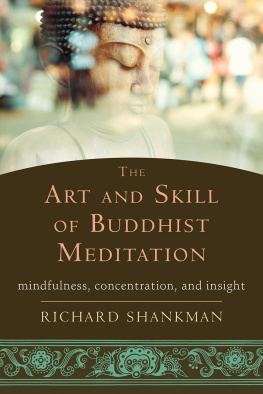This delightful, inspiring, and practical book can help transform anyones meditation practice from a struggle to a joy. Based on years of experience as a gifted psychologist and meditation teacher, Dr. Morgan lucidly shows us how to avoid the pitfalls that make meditation unnecessarily difficult, while finding ways to harness our surprisingly natural capacity for clarity and ease. Full of wisdom and compassion, its a must-read for all who wish to deepen and enliven their meditation practice and live a richer, happier, more connected life.
Ronald D. Siegel, PsyD, author of The Mindfulness Solution
Have you ever wanted to know the secret of a happy meditator? With disarming candor and delightful humor, psychologist Bill Morgan shares hard-won insights gleaned from over forty years on the cushion. He shows us how to bring the qualities of play, delight, gratitude, warmth, and tenderness to mindfulness meditation practice, while remaining rooted in the ancient teachings of the Buddha. This book has the power to liberate the hearts of both novice and seasoned meditators. Spare yourself unnecessary struggle and read it now!
Christopher Germer, PhD, author of The Mindful Path to Self-Compassion
In The Meditators Dilemma, Bill Morgan offers us some of the many fruits of his long meditation experience. His firsthand experience of grappling with the dilemmas that confront most meditators helps illuminate some of the common difficulties and struggles we encounter on the path. In this very helpful book, he offers a wide array of skillful suggestions that allow for a natural and more easeful unfolding of our insight and understanding.
Joseph Goldstein, author of Mindfulness: A Practical Guide to Awakening
A noteworthy reevaluation of one Westerners initial enthusiasm over mindfulness meditation. William Morgan shares his frustrations and his solutions in this timely work.
Mark Epstein MD, author of The Trauma of Everyday Life
Sign up to receive weekly Tibetan Dharma teachings and special offers from Shambhala Publications.

Or visit us online to sign up at shambhala.com/eshambhala.
THE
MEDITATORS DILEMMA
An Innovative Approach to Overcoming Obstacles and Revitalizing Your Practice
BILL MORGAN

SHAMBHALA Boulder 2016
Shambhala Publications, Inc.
4720 Walnut Street
Boulder, Colorado 80301
www.shambhala.com
2016 by Bill Morgan
All rights reserved. No part of this book may be reproduced in any form or by any means, electronic or mechanical, including photocopying, recording, or by any information storage and retrieval system, without permission in writing from the publisher.
Library of Congress Cataloging-in-Publication Data
Names: Morgan, Bill (Psychologist)
Title: The meditators dilemma: an innovative approach to overcoming obstacles and revitalizing your practice / Bill Morgan.
Description: First Edition. | Boulder: Shambhala, 2016. | Includes bibliographical references.
Identifiers: LCCN 2015029253 | eISBN 978-0-8348-4011-9 | ISBN 9781611802481 (pbk.: alk. paper)
Subjects: LCSH: MeditationBuddhism.
Classification: LCC BQ5612 .M67 2016 | DDC 294.3/4435dc23
LC record available at http://lccn.loc.gov/2015029253
For my father, who loved hard and died young
We must risk delight. We can do without pleasure, but not delight. Not enjoyment. We must have the stubbornness to accept our gladness in the ruthless furnace of this world.
Jack Gilbert
MUCH GRATITUDE TO:
Joseph Goldstein, who, since 1978, has supported and inspired me through six years of silent retreats at the Insight Meditation Society and Forest Refuge.
Numerous pioneer teachers who have dedicated their lives to bringing these practices to the West, and who kindled me in the process.
Fellow members of the Institute for Meditation and Psychotherapy, especially Chris Germer, Ron Siegel, Paul Fulton, Jan Surrey, Charles Styron, Trudy Goodman, Susan Pollak, Tom Pedulla, Sara Lazar, Chris Willard, and Nayla Khoury for their enduring support over the past thirty years.
Bill OHanlon, who always believed there was a book forthcoming.
Cindy Barrilleaux, who was there from the beginning; she was persevering in keeping the work grounded and lifting me during darker moments.
Gordon Thomas, who, in the latter stages of the project, helped greatly with consolidation and flow.
Jeanne Ann Whittington, a dear friend who reviewed several iterations of the book with great care and insight.
All of the clients and fellow meditators who inspired me more than they can know.
My dear sister Melanie: steady, loving, and true.
My radiant partner and coteacher, Susan, who pours love into everything she touches and inspires me endlessly.
IT IS DARK AND COLD in the mountains as I shuffle to the meditation hall in my dark robe at three thirty in the morning. Im still half asleep, but my first thought before settling into meditation is, Maybe this will be the day I have an important breakthrough.
The atmosphere in the hall is tense, and the teachers assistant has already begun her ominous, slow pacing in front of the row of meditators. She is carrying a stick the length of a yardstick but wider and thicker. Definitely thicker. This woman is prepared to strike anyone who appears sleepy or uninspired. Of course, there is a certain arbitrariness to her assessment, so one can never relax.
I am twenty years old and have just come across the country during my summer break, highly motivated to find something deep and true, a life-changing insight that would surely reorient my life after the sudden death of my dear father. Numb, shocked, and disenchanted with once-satisfying activities, I am struggling to recapture a sense of purpose. I had read accounts of great breakthroughs in meditation following deep personal loss. If I stay unrelentingly with my meditation practice, perhaps my life will undergo a radical transformation.
The tap on my shoulder comes as a surprise, as does my momentary unwillingness to bow to the woman standing before me. I remind myself that she is only doing this for the benefit of my practice. She wants only to raise my energy and dedication to a higher level. Remembering that life is short, I bow. She reaches to find the soft tissue above my shoulder blade, of which, being thin, I have precious little. Who can blame her if, in the dark, she misses and strikes bone, the stick breaking in half with the force of the strike, one piece crashing into the altar twenty feet away and knocking over a small Buddha statue. She strides to the back of the altar to retrieve another stick and returns to strike my other shoulder harder than the first. There is no time for tears like these, I think. But they do not stop flowing.
The year was 1972. Buddhist psychology and mindfulness were landing in earnest on Western shores, and I attempted to find solace and freedom through meditation. I rode this wave with dedication in those early days, exploring a variety of traditions. Over the next ten years, I would spend six months in a Trappist monastery, a summer at a Zen center, nine months at a Tibetan meditation center, and two three-month periods in retreats at the Insight Meditation Society in Massachusetts.
My choice of intensive environments in which to practice was reinforced by the teaching methods of the times, which actively encouraged a version of the heros journey. Fiery determination and fierce effort were expected in those days. I was on board with that and believed that my inability to have a transformative breakthrough was due to my lack of diligence. The solution was to work still harder.
Next page

